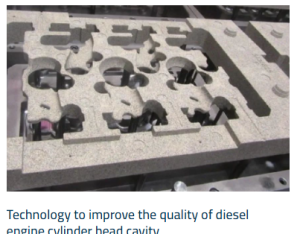Shortening the Design Cycle
Rapid casting is a game-changer when it comes to automotive prototyping, speeding up the design and development time beyond what was conceivable just a few years ago. This process allows rapid creation of molds from a prototype model and later casting the parts with adequate materials, often metals or high performance resins. With rapid casting for automotive applications, you can be having your designs into functional prototypes in a just a few days. It used to take weeks and even months to do likewise in the past. With rapid casting, for example, it only takes 10–14 days to produce a prototype of a complicated engine part but months would have been necessary for doing that in the traditional way.
Cost Efficiency at Its Core
One of the great benefits of using rapid casting for automotive prototype is clearly cost reduction. In direct contrast to traditional casting, which necessitates often expensive tooling and setup, rapid casting makes use of less expensive temporary molds that do not demand the same financial outlays. The affordability of 3D printing means automotive businesses can use it for a number of prototype runs without substantial added costs. According to a recent industry study, companies could reduce their prototype development costs by as much as 50% by using low-volume casting instead of traditional methods.
Real World Testing Material Variability
Whereas 3D printing is a process that builds up the prototype layer by layer, rapid casting works with a variety of materials that more closely resemble the properties of the final product. This flexibility in material is essential when testing in a real-world environment where the components will be used in an actual car. In rapid casting applications, aluminum and magnesium alloys can be used due to their high temperature and stress resistance required by parts such as engine blocks, and transmission cases.

Higher accuracy and better quality
Rapid casting also offers extremely good precision and quality on the prototypes produced. The molds are produced with the use of advanced techniques enabling a very high level of detail and surface finish, crucial when producing automotive parts that need to meet the high standards of the industry. The thing with that high precision is, that it allows the prototypes to not only look right but also work like real, thus reducing the need to amend them in the pre-production stage.
Enabling Complex Geometries
Automotive parts typically contain complex geometries that can be difficult to manufacture with traditional techniques. Quick casting allows for a full-feature approach to these designs without sacrificing the robustness of the prototype. Of particular advantage to the modern lightweight, yet highly durable parts needed for modern automotive design for improved fuel economy and performance, this resides within its ability to achieve a broad range of impact tension variations at various temperatures.
Making Collaboration and Feedback Easier
During design, rapid casting speeds up feedback loops so prototypes may quickly be evaluated, tested, and assessed. LiveParts turns designs quickly, meaning design, engineering and manufacturing teams collaborate even more efficiently to iterate faster than ever. Its much shorter development timeline, on the other hand, translates to quicker market introduction and that is key to gain an edge in the cutthroat automotive sector.
When it comes to automotive prototyping, quick casting optimizes the R&D process and also turns out to be a lucrative, precise, and flexible staging to evaluate and optimize car parts before they go into production. By taking this approach it vastly speeds up innovation and productivity moving the automotive industry ahead step by step with every prototype created.